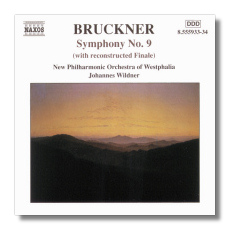
The Internet's Premier Classical Music Source
Related Links
- Bruckner Reviews
- Latest Reviews
- More Reviews
-
By Composer
-
Collections
DVD & Blu-ray
Books
Concert Reviews
Articles/Interviews
Software
Audio
Search Amazon
Recommended Links
Site News
 CD Review
CD Review
Anton Bruckner

Symphony #9 in D minor (ed. Nowak)
with Reconstructed Finale
- Edited by Nicola Samale, Giuseppe Mazzuca, John A. Phillips, Benjamin-Gunnar Cohrs, 1991 / revised 1996
New Philharmonic Orchestra of Westphalia/Johannes Wildner
Naxos 8.555933-34 82:43
Summary for the Busy Executive: Wishful thinking.
As you know, Bruckner died before completing his ninth symphony. He had difficulty working on the final movement. At one point, he suggested that his Te Deum be played as the finale. I wonder if anyone has recorded the symphony this way. I do know that Celibidache included both works in his multi-CD EMI Bruckner set. Bruckner left behind a series of jigsaw-puzzle pieces for the last movement, sketches in a far more incomplete state than those for Mahler's Tenth, which at least existed in short score. Bruckner had what's been called "bifolios," notebooks in which passages were worked out and whose measures were numbered according to a large score of blank measures, prepared by the composer's secretary. The problem is that Bruckner, like any other composer, had second or third thoughts, which he dutifully recorded in later bifolios, and that many of these later notebooks have gone missing. So not only do we have scraps, we're not even sure whether they're day-old scraps. A brace of editors decided to try to complete the mosaic, I guess for fun.
I'll make my standard disclaimer: I'm no Brucknerian. I like the music, but I don't seek it out. There are symphonies I haven't heard and probably never will. I don't go into quasi-religious ecstasy while listening. My favorite of his works, the obscure cantata Helgoland, is my favorite probably because it doesn't sound particularly like Bruckner. Perhaps I'm not the best person to review this CD.
All that said, I regard the Ninth as practically fool-proof. I've never encountered a professional performance, recorded or live, that wasn't at least decent. Wildner's account falls into that category. The Westphalians haven't the gorgeous tone of the front-rank orchestras and treat the symphony more roughly than most. I don't think it merely Wildner's interpretation. Dohnányi and the Cleveland (Decca 425405-2, deleted), for example, put out a hair-raising scherzo, impeccably played. I'd also say that Wildner has trouble getting the Big Picture of the Adagio to come through. The music tends to plod or squeeze out like little sausages, with moments of singing, rather than sing all the way through. This has less to do with tempo per se than with Wildner's and the orchestra's ability to sustain the tempo set.
So whether you want this performance comes down to how much you want to hear the reconstructed finale. How does it compare to that touchstone of reconstructions, Cooke's Mahler 10th? I really wouldn't call this effort revelatory, however much insight it may have given the editors into Bruckner's methods. Indeed, the whole thing feels disjointed and fitful, a rag-and-bones Bruckner, as if the editors had pasted two halves of a photograph together without lining up the edges very well. Metaphorically, the right eye is noticeably higher than the left.
Recorded sound is okay, but you can get better performances in far superior sound.
Copyright © 2008, Steve Schwartz




















